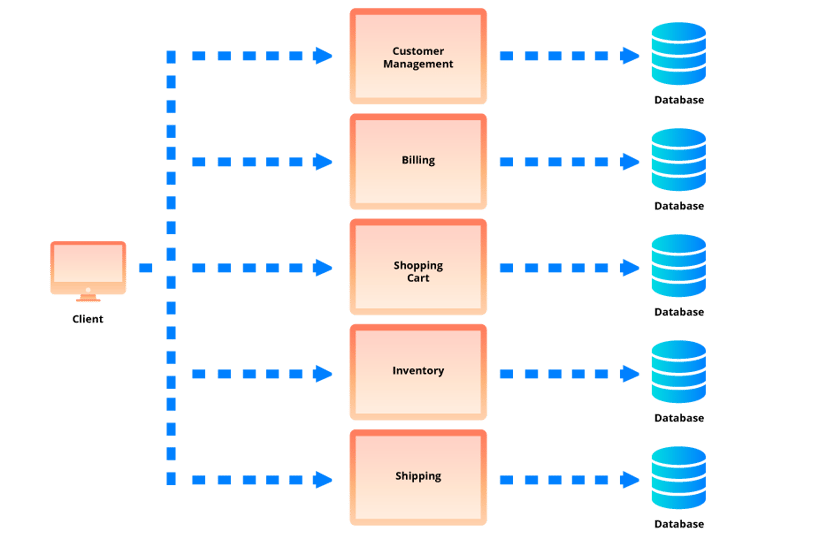Legacy Application Modernization: Key Steps, Benefits & Best Practices
This blog post was co-authored with Riaz Merchant, President and CEO at Mertech. In the fast-paced software world, 'legacy' often signals a warning.
7 min read
 Mertech
:
Nov 22, 2017 12:00:00 PM
Mertech
:
Nov 22, 2017 12:00:00 PM

The digital landscape is rapidly evolving, transitioning from a unified World Wide Web to a fragmented World of Apps.
In this shift, application modernization has become crucial, with microservices emerging as a pivotal component.
But what are application modernization microservices exactly, and how are they changing the digital world as we know it?
Microservices, which depart from traditional monolithic application structures, are integral to modern software architecture. They offer the speed and agility necessary to meet today's technological interactions and innovation demands.
In this article, we'll delve into the role of microservices in application modernization, exploring their impact on transforming software architecture from monolithic to more dynamic, modular systems. We'll also cover some real-life case studies, future trends, and interesting FAQs.
Microservices architecture is an approach to software development where an application is divided into smaller, independent services. Each service performs a specific function and communicates with other services through well-defined APIs.
This method provides greater flexibility, scalability, and resilience, making it a popular choice among companies like Netflix and Google. It supports continuous deployment and integration by enabling teams to update and manage each service separately.
Unlike traditional monolithic applications, where all components are interwoven and deployed as a single unit, microservices allow for independent development, deployment, and scaling of each service.
Here’s a quick comparison:
To see this in action, consider the following example. Before microservices, a typical application structure might have looked like this:

Notice that every request a user makes of the application eventually goes to the same place, regardless of whether the request needs to access one function or several. This may work well in an application’s infancy, when scaling the application by copying it from one server to another and then another is enough to handle increased traffic. But as applications continue to grow, and especially as application traffic continues to increase, monolithic architecture becomes untenable. Scaling the application by copying it over wholesale to separate servers each time traffic increases becomes expensive, and load balancing can only account for so much.
At this point, it might be worth breaking your monolith out into a series of microservices. Here’s what an application running on microservice infrastructure looks like:

With microservices, requests are routed only to the particular pieces of an application that a user needs, splintering traffic and opening your app up for innovation. These services are deployed, scaled, and run separately but can connect when they need to, allowing you to build different subsets of your application that use (and carry traffic for) only a particular set of features.
Monolithic systems, where a single update impacts the entire application, slow down innovation. Microservices counter this by dividing an application into self-contained services, each managed by a dedicated team.
This division allows for independent updates and feature development, accelerating agile development and enabling quicker feature rollouts.
Additionally, modernizing application architecture with microservices and APIs allows developers to access and utilize individual microservices. This facilitates the creation of new applications or features by combining different services, driving innovation beyond the original scope of the application.
Through a, microservices can be seamlessly integrated with other applications, enhancing the functionality and reach of both platforms.
Moreover, microservices minimize risks, as changes in one service don't affect others, fostering a more agile and stable development environment.
However, they still pose some challenges like:
Despite these challenges, for large-scale applications, the advantages of microservices — such as increased innovation, agility, and the ability to respond rapidly to market changes — significantly outweigh the drawbacks.
Modern application framework microservices fundamentally alter how applications are built, maintained, and scaled. This offers a responsive and flexible architecture that aligns with current technological trends.
Here are a few cases of application modernization with microservices:
This process involves dissecting larger, often monolithic, applications into smaller, independent services. Each microservice focuses on a specific function or feature, which leads to more manageable and maintainable codebases.
This transformation is particularly beneficial for legacy systems, where the shift can significantly enhance performance and scalability.
Cloud-native development leverages the scalability and flexibility of cloud computing, enabling applications to be more resilient and adaptable to change.
Microservices fit naturally in this environment, as they can be deployed independently across various cloud environments, improving overall system robustness and efficiency.
By breaking down applications into smaller components, businesses can scale specific functions of an application according to demand rather than scaling the entire application.
This approach also enhances resilience, as the failure of one microservice doesn’t bring down the entire system. Additionally, the flexibility offered by microservices allows for quicker adaptation to changing business requirements and technological advancements.
Transitioning to a microservices architecture can help you modernize your legacy software applications. Here are some effective strategies to guide this transition:
Ensuring a smooth transition to a microservices-based architecture requires careful planning and execution. Here are some best practices and common pitfalls to keep in mind:
Freight Management Systems: Revolutionizing Logistics with Mertech
Context: Freight Management Systems, a trailblazer in transportation logistics software, sought to modernize its 25-year-old legacy TMS software.
The challenge? Transitioning from a desktop-based system to a cloud-based solution for enhanced global competitiveness.
Process: Partnering with Mertech, FMS aimed to rejuvenate their platform without re-writing their extensive back-end code. Mertech used the Thriftly platform, allowing the reuse of existing back-end code to create APIs, drastically simplifying the modernization process. This approach focused on transforming the front-end, introducing web-based modules while maintaining the functionality of the existing system.
Result: The transformation led by Mertech marked a pivotal shift for FMS. Not only did it significantly improve their product's design and functionality, but it also enabled FMS to offer additional services like EDI. This modernization opened doors to new integrations, increasing customer value and loyalty. It positioned FMS to efficiently cater to the evolving demands of a remote workforce and expand their reach in the logistics industry.
Emerging application modernization trends suggest a deeper integration of AI and machine learning within microservices, further enhancing automation and predictive capabilities in application management. Furthermore, the rise of serverless architectures is likely to streamline development processes, reducing overhead and fostering innovation.
As we embrace these advancements, it's crucial to recognize that the journey of application modernization is a continuous one, requiring ongoing adaptation and learning.
If you're planning to make this technological change to your business, look no further than Mertech. We can take charge of your application modernization efforts and improve your competitiveness in the rapidly evolving digital landscape.
Assess your application's complexity and scalability needs.
If it's large, monolithic, and requires scalability and flexibility, it's likely a good candidate. Applications that need frequent updates or have components that can function independently also benefit from a microservices approach.
Some of the primary benefits of a microservices architecture include:
While they come with a number of benefits, microservices often come with challenges like:
Containers offer an isolated environment for each microservice, ensuring consistent operation across different computing environments. They facilitate easy scaling, deployment, and management of microservices, making them integral to modernization efforts.
You should implement robust monitoring tools (like Prometheus and Grafana) that offer insights into each microservice's performance.
Also, to ensure consistency and efficiency, you can adopt automated deployment and management tools like Kubernetes, Docker, and Zipkin.
Lastly, you can establish clear logging and observability practices to track and diagnose issues.
When selecting tools and technologies for microservices implementation, it's essential to consider several key factors, including:

This blog post was co-authored with Riaz Merchant, President and CEO at Mertech. In the fast-paced software world, 'legacy' often signals a warning.

This post was co-authored with Riaz Merchant, President/CEO at Mertech Data Systems, Inc.

Shifting from your traditional legacy systems to the Cloud can be a game changer, as the benefits of cloud migration are numerous. Cloud computing...